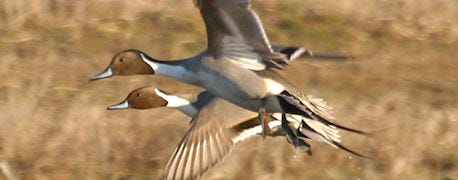June 11, 2013

Your ears should have been burning last week.
Federal, state and private conservation and wildlife officials met in Bismarck, N.D., to talk about what several called a "crisis" of land use east of the Missouri River in South Dakota and North Dakota.
They are worried about what farmers are doing with their land today in light of high crop prices, and what they might do with when a new Farm Bill passes.
Their big concerns:
•The conversion of grasslands and CRP acres to cropland. They say it is happening at a rate not seen since the Dust Bowl.
•The draining of wetlands and the tiling of cropland.
•The fragmentation of the landscape by farming and oil exploration.

Ducks settle into a wetland. Conservation officials worry that their habitat is about to disappear.
The changes in the landscape may be nearing a tipping point, said Dan Ashe, director of the U.S. Fish and Wildlife Service.
If more uplands and wetlands are lost to farming and oil development, pheasant and waterfowl populations may begin a decline that may be impossible to stop.
"The reality is that we're asking a lot of this landscape," Ashe said. "It's pretty clear that it can't provide everything to everybody. It produces food and fiber, now energy for the United States and continues to provide the bounty of waterfowl and wildlife [habitat] that it has provided for thousands of years. If that's going to continue, we're going to have to ask people to make responsible choices."
By the end of the two-day summit, a strategy for protecting more land emerged that included:
•Raising more money for and redirecting more money to the Prairie Pothole region so federal and state agencies and private groups can buy more land and easements. Additional money might come from a new Duck Stamp; from southern states that have ducks in the winter; and from penalties, fines and settlements in environmental cases such the Gulf of Mexico oil spill. The money could be put to use quickly. Currently, landowners in the Dakotas have expressed interest in selling wetland or grassland easements on 232,000 acres. It would cost $145 million today to buy those perpetual easements, estimates Jim Ringelman, Ducks Unlimited's director of conservation programs.
•Convincing Congress to link crop insurance premium subsidies to conservation compliance. They fear if there isn't a link, large numbers of landowners will abandon the program and begin draining wetlands that have been protected for the past 20-30 years. They also talked about getting a new sodbuster ban in the Farm Bill.
•Increasing winter wheat acres. Winter wheat will support nearly as many nests as grassland and 24 times as many as spring wheat.
Waterfowl populations are currently at record high numbers, partly due to the wet weather in recent years. In the Dakota's, the birds are living on approximately 1 million acres of easements and another 10 million acres of pasture, native grassland and CRP.
Conservation and wildlife officials would like to figure out how to at least maintain the habitat.
"Our goal," said Dale Hall, CEO of Ducks Unlimited, which organized the Prairie Summit, "is to have sufficient wetlands to fill the sky with waterfowl today, tomorrow and in the future."
You May Also Like




